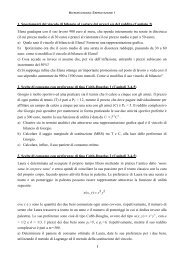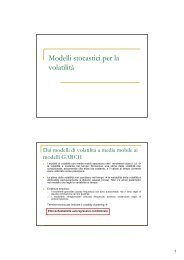Teoria della selezione del portafoglio e modelli di equilibrio del ...
Teoria della selezione del portafoglio e modelli di equilibrio del ...
Teoria della selezione del portafoglio e modelli di equilibrio del ...
Create successful ePaper yourself
Turn your PDF publications into a flip-book with our unique Google optimized e-Paper software.
SIMULAZIONE<br />
Determinazione <strong>del</strong> <strong>portafoglio</strong> efficiente componendo i tre business B, D, E. (I dati utilizzati si rifanno<br />
alle tabelle 2, 3 e 4, arrotondati alla quarta cifra decimale). Si ponga <strong>di</strong> voler ottenere un ren<strong>di</strong>mento<br />
atteso <strong>di</strong> <strong>portafoglio</strong> <strong>di</strong> 15.6.<br />
⎧ n<br />
⎪<br />
n n<br />
∑ xi<br />
= 1<br />
⎪ i=<br />
1<br />
F.O. = min 0.5 VP = min 0.5 ∑∑<br />
xixjσ ij con vincoli ⎨ n<br />
i=<br />
1 j=<br />
1<br />
⎪<br />
*<br />
⎪∑<br />
xR i i = RP<br />
⎩ i=<br />
1<br />
⎛ 3 ⎞ ⎛ 3 ⎞<br />
*<br />
Lx ( i, λS, λR) = 05 . VP + λ ⎜ S⎜ 1−∑x⎟<br />
i⎟<br />
+ λ ⎜ R⎜ RP −∑xR⎟<br />
i i⎟<br />
⎝ ⎠ ⎝<br />
⎠<br />
i=<br />
1<br />
i=<br />
1<br />
⎛ σ σ σ ⎞⎛<br />
x ⎞<br />
⎜<br />
⎟⎜<br />
⎟ ⎛ ⎞ ⎛<br />
⎞<br />
Lx ( i, λS, λR)<br />
= . ( x x x)<br />
⎜σ<br />
σ σ ⎟⎜<br />
x ⎟ + λ ⎜ S − x ⎟<br />
⎜ i⎟<br />
+ λ ⎜ R RP − xiR ⎟<br />
⎜<br />
i⎟<br />
⎜<br />
⎟⎜<br />
⎟<br />
σ σ σ x<br />
⎝<br />
⎝<br />
i ⎠ ⎝<br />
⎠<br />
i ⎠<br />
⎝ ⎠<br />
x<br />
. [ ( x σ x σ x σ )( x σ x σ x σ )( x σ x σ x σ ) ] x<br />
x<br />
λ S<br />
=<br />
⎛ ⎞<br />
⎜ ⎟<br />
= + + + + + + ⎜ ⎟<br />
⎜ ⎟<br />
⎝ ⎠<br />
+<br />
11 12 13 1<br />
3<br />
3<br />
∗<br />
05 1 2 3 21 22 23 2 1 ∑ ∑<br />
= 1<br />
= 1<br />
31 32 33 3<br />
1<br />
05 1 11 2 21 3 31 1 12 2 22 3 32 1 13 2 23 3 33 2<br />
3<br />
⎛ ⎞ ⎛<br />
⎞<br />
+ ⎜<br />
∗<br />
1−∑x<br />
⎟<br />
⎜ i ⎟<br />
+ ⎜ R RP −∑x<br />
R ⎟<br />
⎜<br />
i i⎟<br />
⎝ i=<br />
⎠ ⎝ i=<br />
⎠<br />
[ x ( x x x ) x ( x x x ) x ( x x x ) ]<br />
∗<br />
S ∑xi R RP ∑xiRi<br />
i=<br />
i=<br />
x x x x x x x x x<br />
=<br />
= + + + + + + + + +<br />
⎛ ⎞ ⎛<br />
⎞<br />
+ ⎜<br />
− ⎟<br />
+ ⎜ − ⎟<br />
⎜<br />
⎟<br />
⎝ ⎠ ⎝<br />
⎠<br />
=<br />
3<br />
3<br />
λ<br />
1<br />
1<br />
05 . 1 1σ11 2σ213σ31 2 1σ122σ223σ3231σ13 2σ233σ33 3<br />
3<br />
λ 1 λ<br />
1<br />
1<br />
= 05 . σ + σ + σ + σ + σ + x σ + x x σ + x x σ + x σ +<br />
=0.5<br />
1 2 11 1 2 21 1 3 31 1 2 12 2 2<br />
( 22 2 3 32 1 3 13 2 3 23 3 )<br />
S x x x R RP x R x R x R<br />
2<br />
33<br />
+ λ 1−<br />
1 − 2 − 3 + λ<br />
∗<br />
− 1 1 − 2 2 − 3 3 =<br />
( ) ( )<br />
per la simmetria <strong>del</strong>le covarianze si ha:<br />
2 ( x1σ11 2<br />
x2σ22 2<br />
x3σ332x1x2σ12 2x1x3σ13 2x2x3σ23)<br />
∗<br />
+ λS( 1−<br />
x1 − x2 − x3) + λR(<br />
RP − x1R1 − x2R2 − x3R3) =<br />
+ + + + + +<br />
L'ottimo si ha uguagliando a zero le derivate parziali:<br />
⎧ ∂L<br />
1<br />
⎪ = ( 2x1σ11 + 2x2σ12 + 2x3σ13) −λS − λRR1<br />
= 0<br />
⎪<br />
∂x1<br />
2<br />
⎪ ∂L<br />
1<br />
⎪ = ( 2x2σ22 + 2x1σ21 + 2x3σ23) −λS − λRR2<br />
= 0<br />
⎪<br />
∂x2<br />
2<br />
⎪ ∂L<br />
1<br />
⎨ = ( 2x3σ33 + 2x1σ31 + 2x2σ32) −λS − λRR3<br />
= 0<br />
⎪∂x3<br />
2<br />
⎪ ∂L<br />
⎪ = 1−x1 − x2 − x3 = 0⇒ x1 + x2 + x3<br />
= 1<br />
⎪∂λ<br />
S<br />
⎪ ∂L<br />
⎪ = R − R1x1− R2x2− R3x3= 0 ⇒ R1x1+ R2x2+ R3x3= R<br />
⎩∂λ<br />
R<br />
che posto in forma matriciale:<br />
∗ ∗<br />
P P<br />
47
















